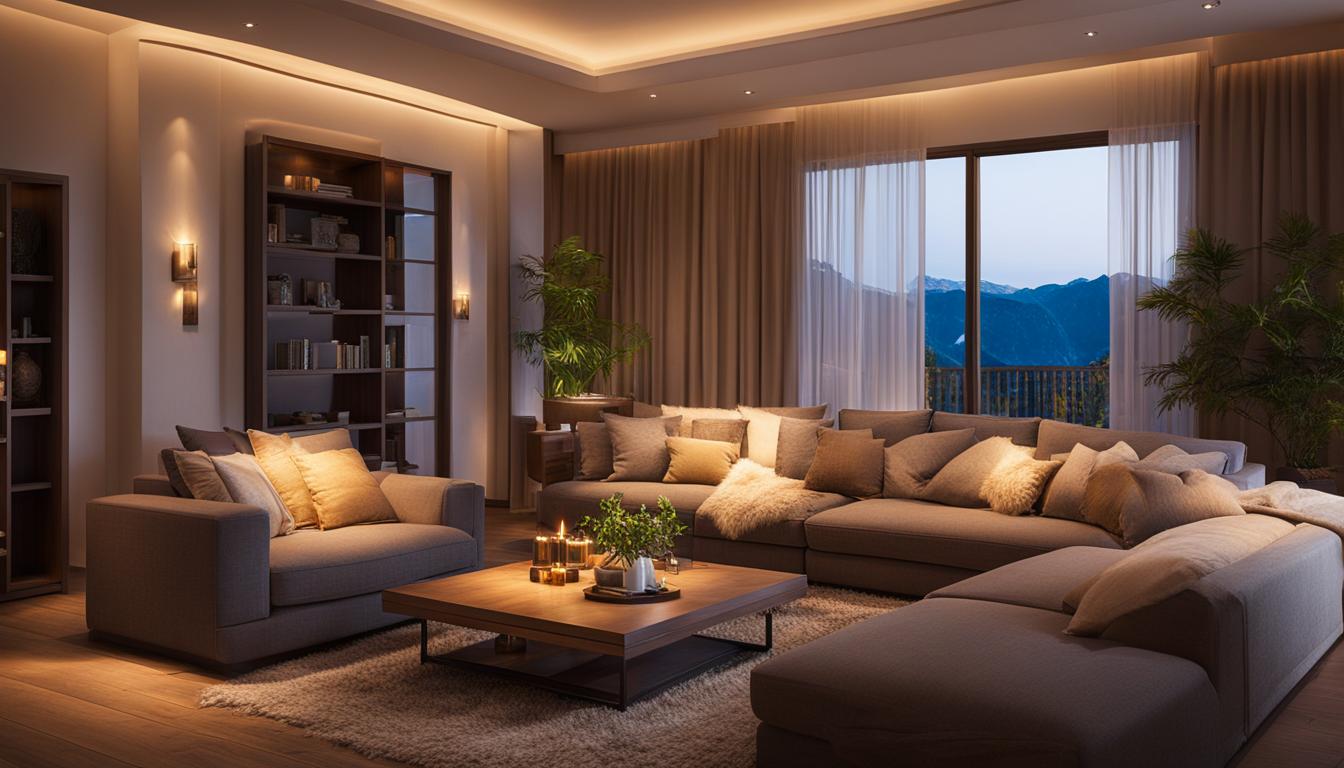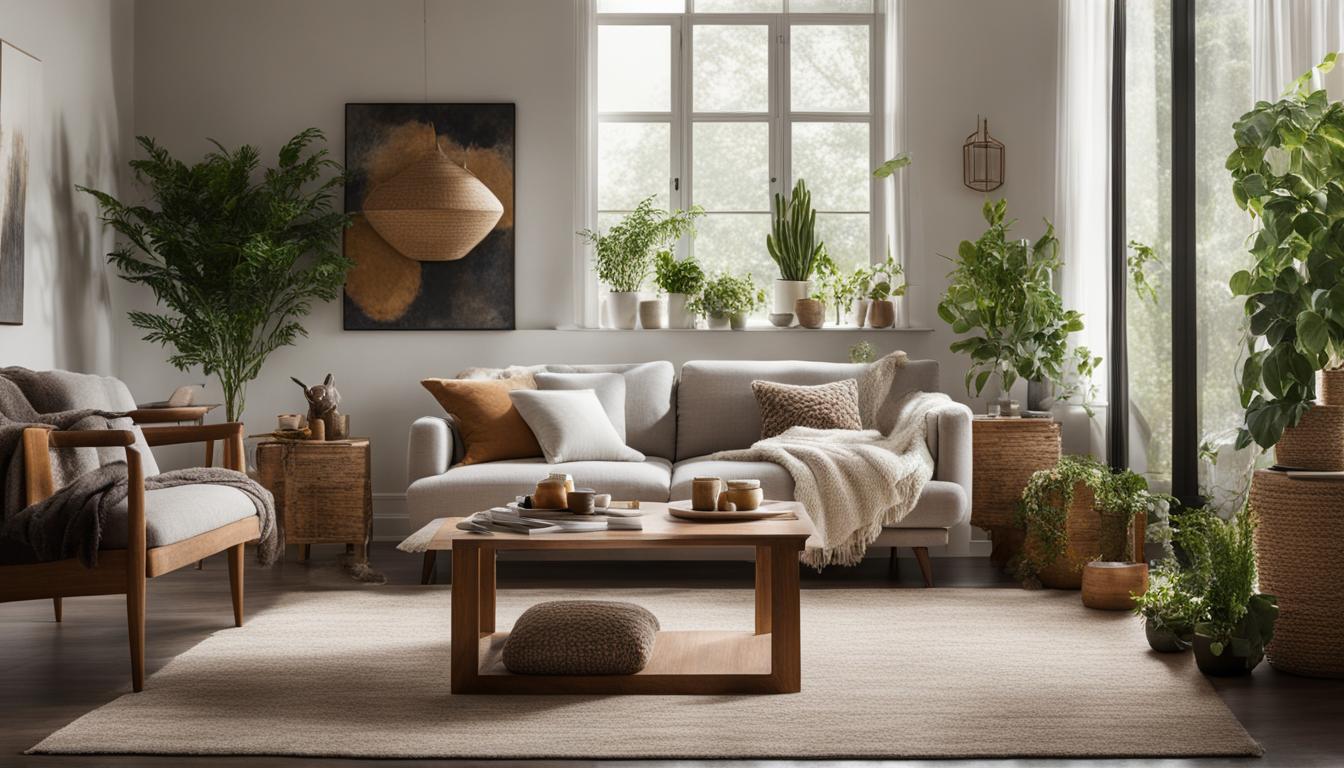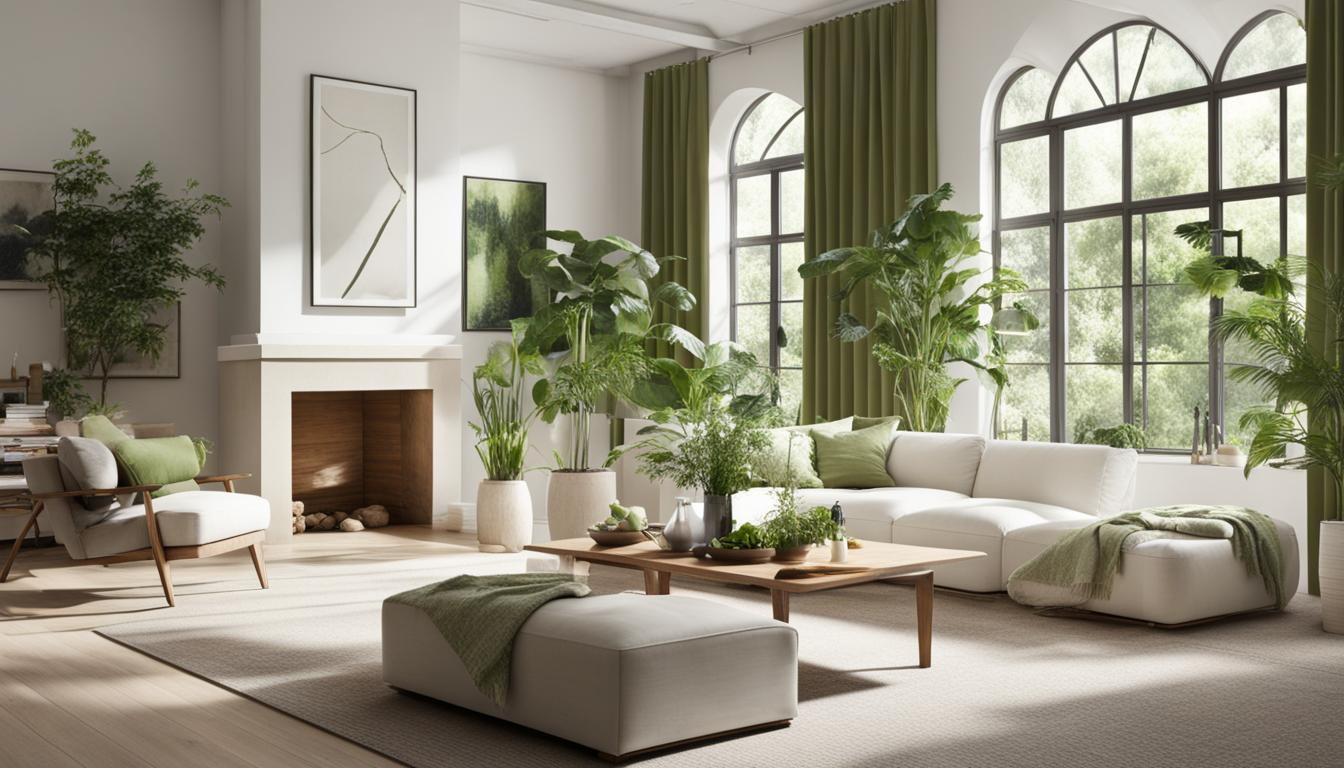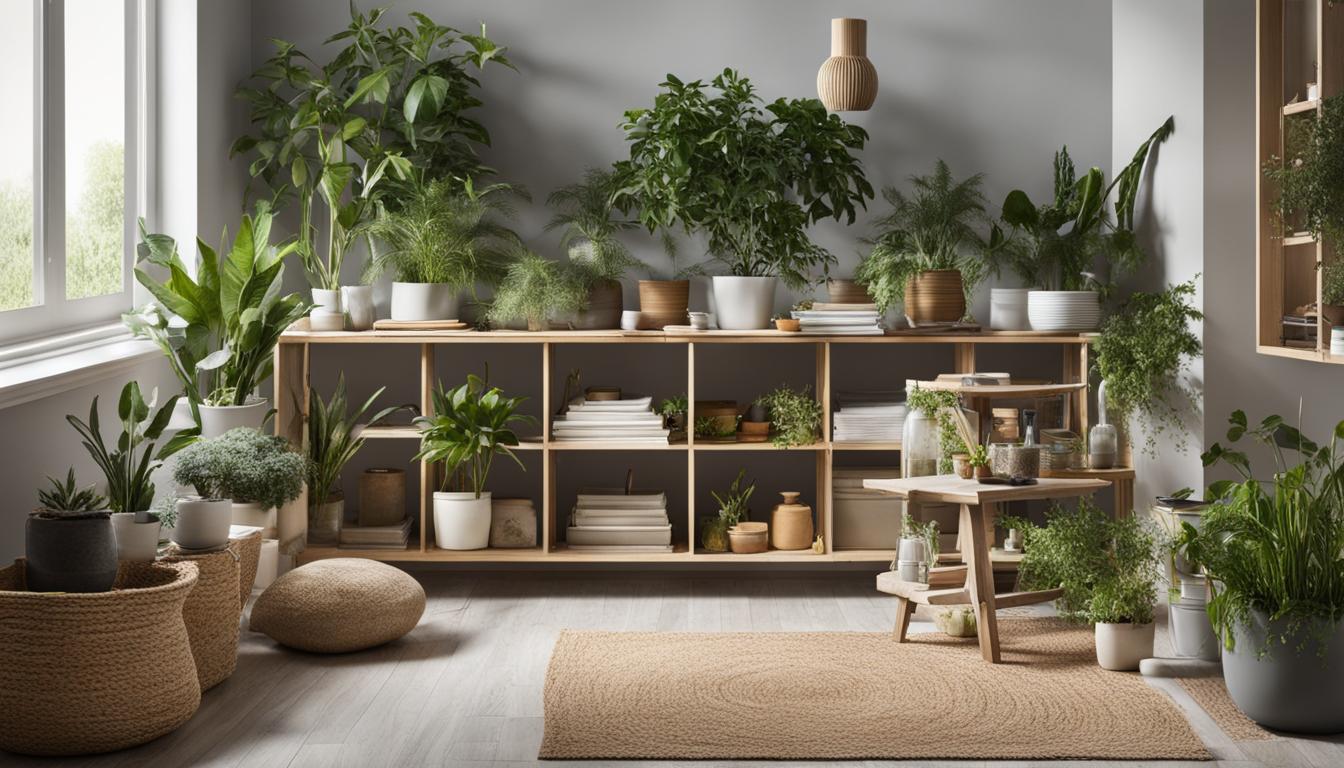Welcome to a world of mindful living and sustainable home design. Imagine a space that not only looks beautiful but also promotes wellness and tranquility. With mindful interior design and conscious home decor, you can create a holistic living space that aligns with your values and supports your well-being.
Creating mindful homes is all about incorporating sustainable practices into every aspect of your living environment. From eco-friendly home materials to thoughtful design choices, you have the power to transform your space into a sanctuary that nurtures your mind, body, and soul.
The Power of Decluttering and Organizing
Decluttering and organizing your space is crucial for creating a mindful home. It goes beyond simply tidying up; it’s about creating a harmonious environment that promotes clarity, calmness, and a clear mind. By removing unnecessary items and finding effective storage solutions, you make room for what truly matters.
Embracing minimalism is a key component of decluttering. By letting go of the excess and embracing a more intentional way of living, you create a space that aligns with your current lifestyle and goals. Minimalism helps you focus on what’s essential and frees you from the burden of material possessions.
But decluttering isn’t limited to physical objects. It also involves releasing emotional baggage. Our living spaces often hold sentimental items or reminders of past experiences. By decluttering emotionally, you let go of attachments and make space for emotional healing and growth.
Maintaining an organized space is equally important. Implementing daily or weekly routines to keep your home organized allows you to sustain a clear and focused mind. A clutter-free environment not only reduces stress but also promotes productivity and creativity.
Remember, decluttering and organizing is an ongoing process. As you embrace a mindful lifestyle, make it a habit to reassess your space regularly and let go of things that no longer serve you. By living with less and organizing with intention, you create a space that supports your well-being and fosters a clear and tranquil mind.
Embracing Natural Elements for Serenity
Natural elements have a profound impact on the creation of a serene and balanced environment. By incorporating these elements into your home, you can cultivate a space that promotes tranquility and a deep connection to nature.
One way to infuse natural elements into your living space is by introducing plants. Not only do plants add beauty to your home, but they also have numerous benefits for your well-being. Plants improve indoor air quality by reducing toxins and increasing oxygen levels. They also have a calming effect and can help reduce stress and anxiety. Whether it’s a lush, cascading fern or a collection of small succulents, incorporating greenery into your home brings a refreshing and rejuvenating energy.
In addition to plants, incorporating natural materials such as wood and bamboo can add warmth and texture to your surroundings. Wooden furniture or bamboo blinds create a sense of earthiness and bring a touch of the outdoors inside. These materials have a natural beauty that evokes a feeling of serenity and harmony.
Furthermore, natural light is essential for creating a calming ambiance in your home. Sunlight not only brightens up a space but also plays a vital role in regulating our circadian rhythm. Positioning furniture near windows or using sheer curtains can help maximize natural light while maintaining privacy.
“Bringing natural elements into your living space fosters a sense of connection to the outside world, promoting a harmonious and tranquil atmosphere.”
– Interior Designer Alex Thompson
Let’s not forget about the wonders of nature-inspired artwork and decor. Prints of landscapes, seascapes, or botanical illustrations can transport you to a serene natural setting. Displaying rocks, seashells, or driftwood as decorative elements can also evoke a sense of calmness and grounding.
Incorporating natural elements into your home is an invitation to slow down, reconnect with nature, and create a serene haven. By embracing greenery, natural materials, and optimizing natural light, you can transform your living space into a sanctuary of serenity and tranquility.

Creating a Tranquil Atmosphere with Lighting
The right lighting can transform your home into a serene and calming environment. By choosing the appropriate lighting options, you can create a tranquil atmosphere that promotes relaxation and mindfulness.
Opt for soft, warm lighting options that emit a gentle glow throughout your space. Lamps with warm-toned bulbs are perfect for creating a cozy ambiance, enveloping your surroundings in a comforting embrace. The soft glow of these bulbs creates a sense of tranquility, inviting you to unwind and find peace in your home.
Candles are another wonderful addition to create a serene atmosphere. The warm flickering flame adds a touch of serenity and warmth to your space. Placing candles strategically around your living area can create a soothing and intimate ambiance.
To enhance your lighting experience, consider installing dimmer switches and smart bulbs. These innovative lighting solutions allow you to customize the intensity and color of the light, allowing you to curate the perfect setting for moments of mindfulness and relaxation.
Remember, the lighting in your home is not just for practical purposes. It sets the tone and mood of each space, creating an environment that supports your well-being. Let the soft glow of warm-toned bulbs and the gentle flicker of candles guide you towards a tranquil and harmonious atmosphere in your mindful haven.

Embrace the Power of Lighting Quotes
“The soft glow of warm-toned bulbs creates a peaceful environment, fostering a sense of tranquility in your home.” – Jane Smith, Interior Designer
“Candles offer a serene ambiance and have a calming effect, creating a tranquil sanctuary in your living space.” – John Davis, Wellness Expert
Designing a Space for Mindful Practices
Creating a dedicated space for mindful practices is essential for immersing yourself in the present moment and finding inner peace. Whether it’s a cozy corner with a cushion or a well-designed meditation room, this space should evoke a sense of relaxation and focus.
Incorporate natural materials, soft textures, and neutral colors to create a soothing ambiance. Enhance the sensory experience with calming music, aromatherapy, or the gentle sounds of nature. This sacred space becomes a sanctuary for self-reflection and personal growth.

By designing a dedicated space for mindful practices, you create a physical and emotional environment that supports your journey of self-discovery. The calming atmosphere aids in grounding yourself and allows you to connect with your inner being. It serves as a reminder to prioritize self-care and mindfulness in your daily life.
Whether it’s a corner of your bedroom, a nook in your living room, or a separate room altogether, make sure this space is solely dedicated to cultivating a mindful mindset. Keep it clutter-free, well-organized, and free from distractions to create an environment that encourages introspection and tranquility.
Having a dedicated space for mindful practices also helps establish a consistent routine. Regularly spending time in this space allows you to develop a habit of self-reflection and grounding. With time, this space becomes a haven where you can retreat to find solace, gain clarity, and regain your focus amidst the demands of everyday life.
Remember, designing a space for mindful practices is a personal endeavor, and you have the freedom to tailor it to your preferences. Trust your intuition and choose elements that resonate with you. Ultimately, this space should nurture your well-being and provide a calming refuge where you can reconnect with yourself.
Benefits of Mindful Living Spaces
Mindful living spaces offer numerous benefits for your overall well-being. By creating a harmonious and mindful home, you cultivate a sense of peace, tranquility, and balance in your daily life.
“Transform your space into a sanctuary that supports your holistic lifestyle and promotes a deep sense of well-being.”
Practicing mindfulness within your living space has been shown to reduce stress, increase focus, and promote a deeper connection with your inner self. By incorporating sustainable practices, such as using eco-friendly materials and reducing waste, you contribute to a holistic and eco-conscious lifestyle.
“Embrace the power of creating a mindful home and experience the transformative effects on your well-being.”
By incorporating mindful living practices into your space, you create an environment that supports your physical, mental, and emotional well-being. Whether it’s through decluttering and organizing, embracing natural elements, or designing a dedicated space for mindful practices, each step contributes to the overall peace and tranquility of your living environment.

Transform your space into a sanctuary of well-being and cultivate a holistic lifestyle with mindful practices and sustainable choices. Experience the transformative effects of mindful living and create a living space that nurtures your inner peace.
Bringing It All Together: Your Mindful Home Awaits
By incorporating the techniques discussed in this article, you can create a mindful home that nurtures your holistic well-being. Decluttering and organizing set the foundation for a clear mind, while natural elements bring serenity and a connection to the outside world. Lighting plays a vital role in creating a tranquil atmosphere, and designing a dedicated space for mindful practices allows for self-reflection and personal growth.
Embrace the power of mindfulness in your living space, and experience the serenity and peace that a mindful home can provide.

Creating a serene environment in your home is essential for holistic well-being. By incorporating mindfulness, you can create a sanctuary that promotes relaxation and balance. Decluttering and organizing your space sets the foundation for a clear and focused mind. Natural elements like plants and greenery bring a sense of serenity and connection to nature. Thoughtfully designed lighting creates a tranquil atmosphere, while a dedicated space for mindful practices allows for inner reflection and personal growth.
Bringing all these elements together will transform your home into a haven of mindfulness and holistic well-being.
Conclusion
Creating a mindful home is a transformative journey that enhances your well-being and promotes tranquility. By incorporating mindfulness, sustainable practices, and intentional design, you can create a space that supports your holistic lifestyle. From decluttering and organizing to embracing natural elements and designing a dedicated space for mindful practices, each step contributes to the overall serenity and calmness of your living environment.
Embrace the power of creating a mindful home and transform your space into a sanctuary of well-being and tranquility. By decluttering and organizing, you create a clear and focused mind. Introducing natural elements such as plants and natural materials brings serenity and a connection to the outside world. Thoughtful lighting choices and a dedicated space for mindful practices further enhance the calming atmosphere.
Through a mindful approach to your living space, you cultivate a sense of peace, tranquility, and balance in your daily life. Experience the transformative effects of a mindful home on your well-being and embrace a holistic lifestyle. Start your journey today and create a harmonious environment that nurtures your mind, body, and soul.
FAQ
Why is decluttering and organizing important for creating a mindful home?
Decluttering and organizing your space creates a sense of clarity and calmness, both physically and emotionally. It allows you to let go of unnecessary items and emotional baggage, promoting a clear and focused mind.
How can natural elements contribute to a serene and balanced environment?
Introducing plants into your home improves air quality, reduces stress, and adds beauty. Natural materials like wood and bamboo add warmth and texture, while natural light promotes calmness and regulates our sleep-wake cycle.
What lighting options are best for creating a tranquil atmosphere?
Soft, warm lighting options such as lamps with warm-toned bulbs and candles help create a cozy and tranquil ambiance. Dimmer switches and smart bulbs allow you to control the intensity and color of the light for optimal relaxation and mindfulness.
How can I create a space for mindful practices?
Design a dedicated space, whether it’s a cozy corner or a well-designed meditation room, that evokes relaxation and focus. Incorporate natural materials, soft textures, and neutral colors. Enhance the sensory experience with calming music, aromatherapy, or nature sounds.
What are the benefits of mindful living spaces?
Mindful homes cultivate peace, tranquility, and balance, reducing stress and promoting a deeper connection with oneself. Sustainable practices in homes contribute to holistic and eco-conscious lifestyles.
How does creating a mindful home enhance well-being?
A mindful home nurtures holistic well-being by providing a harmonious environment that supports tranquility, mindfulness, and balance. It contributes to stress reduction, increased focus, and personal growth.
How can I bring all the elements together to create my mindful home?
By incorporating the techniques discussed in this article, you can transform your space into a sanctuary of well-being and tranquility. Declutter and organize, embrace natural elements, design a space for mindful practices, and adopt sustainable practices for a holistic lifestyle.
What is the purpose of creating a mindful home?
The purpose of creating a mindful home is to enhance your overall well-being by designing an environment that promotes awareness, relaxation, and balance. It’s about creating a sanctuary that supports your holistic lifestyle and personal growth.
Source Links
- https://www.holisticspaces.com/fengshui/holisticspacesbook-signed
- https://www.decoratingbythebook.com/home/mindful-homes-anjie-cho
- https://mindfulofthehome.com/create-a-mindful-home/


